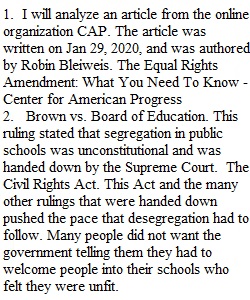


Q HIS 200 Module Six Short Response Guidelines and Rubric Overview: The short response activities in the webtext throughout this course are designed to show your understanding of key concepts as you engage with course content. Prompt: During the sixth week of the course, you will respond to several questions in the webtext as you complete each learning block. At the end of Module Six you will review your answers to these questions and ensure that you have responded to each question. It is important that you answer each question; otherwise, the words “[no response]” will appear in brackets when you submit the assignment. The questions and their original locations in the webtext are listed in this table in case you want to refer back to the reading as you edit, but you can edit your responses to all the questions directly in Module Six: Analyzing History, continued, learning block 6-4 (page 2) in the webtext before exporting to Word for submission to your instructor in the learning environment. Module Six: Analyzing History, continued, Learning Block 6-1 (page 2): ? Question 1: Which source will you analyze using active reading strategies? Include the name of the article, the author, the publication, the date, and where you found it. Read your chosen source using the active reading strategies you learned on the previous page. Then, summarize the overall meaning and content of the reading. Write your summary below. Your summary should be at least one paragraph long. Module Six: Analyzing History, continued, Learning Block 6-2 (page 2): ? Question 2: What events or historical forces contributed to the Boston busing crisis of the mid-1970s? Name at least three, and briefly explain why you think each one was a contributory cause of the Boston busing crisis. ? Question 3: Name three specific consequences of the Boston busing crisis. Module Six: Analyzing History, continued, Learning Block 6-3 (page 3): ? Question 4: Describe one cause of the event you have chosen for your historical analysis (keeping in mind that there are many), and explain one piece of evidence from your research that you will use to support this assertion. Describe one consequence of the event, and explain one piece of evidence from your research that you will use to support this assertion. Rubric Guidelines for Submission: Your responses to Questions 1 and 4 should be 1 paragraph long. Your responses to Questions 2 and 3 should be 2–3 sentences long. Follow the instructions at the bottom of Module Six: Analyzing History, continued, learning block 6-4 (page 2) in the webtext, to download your work and submit it to your instructor as a single Microsoft Word document uploaded to the learning environment. Refer to the Submitting Webtext Assignments Guide for assistance on downloading, saving, and submitting this assignment. Critical Elements Exemplary Proficient Needs Improvement Not Evident Value Engagement Written responses completely address all short answer prompts (100%) Written responses completely address the majority of short answer prompts (85%) Written responses address the minority of short answer prompts (55%) No written responses provided to address any short answer prompts (0%) 30 Relevance Written responses directly address short answer prompts, drawing from presented course concepts and terminology (100%) Written responses are topically related to short answer prompts, but responses do not consistently draw from presented course concepts and terminology (85%) Written responses do not address topics identified in short answer prompts (0%) 20 Accuracy Written responses are completely accurate (100%) Written responses contain minor errors but are mostly accurate (85%) Written responses contain major errors (55%) No written responses are provided (0%) 20 Critical Thinking Written responses demonstrate understanding of course content through inclusion of original ideas and examples (100%) Written responses demonstrate understanding of course content through reiteration of provided materials, but do not consistently include original ideas and examples (85%) Written responses do not reflect original ideas and examples (0%) 20 Articulation of Response Written responses are captured in complete sentences without grammatical errors impacting legibility and the clarity of response (100%) Written responses are captured in incomplete sentences or include numerous grammatical errors that negatively impact legibility and the clarity of response (85%) No written responses are captured in complete sentences (0%) 10 Total 100%
View Related Questions